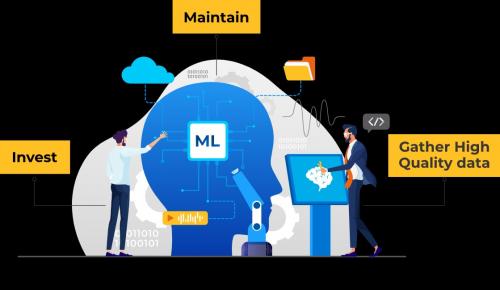A Comprehensive Guide to Understanding m3db: Everything You Need to Know
Introduction to m3db;
Welcome to the world of m3db – a powerful and innovative time-series database that is revolutionizing the way data is stored, queried, and analyzed. If you're looking to take your data management to the next level, then you've come to the right place. In this comprehensive guide, we will delve into everything you need to know about m3db – from its history and architecture to its benefits, use cases, best practices, troubleshooting tips, comparisons with other databases, and future developments. So sit back, relax, and let's embark on this exciting journey of exploring the depths of m3db!
History and Evolution of m3db;
m3db, a revolutionary time-series database, has an intriguing history worth exploring. Initially developed by engineers at Uber in 2016, m3db was designed to handle the massive scale and complexity of their data infrastructure. Over the years, it has evolved into a robust and reliable solution used by various industries worldwide.
With continuous innovation and feedback from users, m3db has undergone significant enhancements to improve performance and scalability. Its journey from a simple internal tool to a full-fledged open-source project showcases its adaptability and versatility in meeting diverse data storage needs.
The relentless pursuit of excellence has driven the evolution of m3db into what it is today – a sophisticated database that empowers organizations to manage their time-series data with efficiency and precision. As technology continues to advance, we can only anticipate further exciting developments on the horizon for m3db.
Understanding the Architecture of m3db;
When diving into the architecture of m3db, it's essential to grasp its distributed design. The system is built on a masterless and decentralized approach, where each node operates independently but collaborates seamlessly with others in the cluster. This ensures high availability and fault tolerance for your data.
At the core of m3db lies a time series database that organizes data into sharded blocks, allowing for efficient storage and retrieval of time series data at scale. Each shard can be replicated across multiple nodes to prevent data loss or corruption. Moreover, m3db employs a write-ahead log (WAL) mechanism to ensure durability by persisting incoming writes before committing them to disk. This guarantees that no data is lost during unexpected failures or crashes.
In addition, m3db leverages an embedded query engine that enables complex queries to be executed directly within the database without relying on external systems. This streamlines data processing and enhances overall performance for users handling large volumes of time series data.
Benefits and Advantages of Using m3db;
Are you looking for a scalable and efficient database solution? Look no further than m3db. One of the key benefits of using m3db is its ability to handle large volumes of time-series data with ease. This makes it ideal for applications where real-time analytics and monitoring are crucial.M3db, also known as the Multi-Mode Multi-Dimensional Database, is a popular open-source time-series database that has gained significant traction in recent years. It offers a variety of benefits and advantages for users, making it a preferred choice for many companies and organizations.
Scalability is one of the key benefits of using m3db. This database is designed to handle large amounts of data with ease, making it suitable for high-scale applications. It uses a distributed architecture that allows for seamless scaling across multiple nodes, ensuring that performance remains consistent even as data volumes increase.
Another advantage of m3db is its efficient storage mechanism. This database utilizes a unique approach called "aggregation trees" to store data in an optimized manner. Aggregation trees allow for faster retrieval and querying of data while reducing the amount of storage space required. This makes m3db a cost-effective option for storing large amounts of time-series data.
Furthermore, m3db offers robust support for real-time analytics and monitoring. Its efficient query engine allows users to run complex queries on real-time data without any noticeable latency or delay. This capability is particularly useful in industries such as finance, healthcare, and telecommunications where timely analysis of streaming data can make a significant impact on decision-making processes.
In addition to its technical benefits, m3db also offers several advantages from an operational standpoint. Firstly, it supports easy integration with various tools and platforms commonly used in modern software development such as Kubernetes and Prometheus. This enables developers to seamlessly incorporate m3db into their existing workflows without having to make major changes to their infrastructure.
Moreover, m3db's community-driven development model ensures frequent updates and improvements are made available through regular releases. The active community surrounding this database provides valuable support and resources for users through forums, documentation, and meetups.
Another major benefit of using m3db is its cost-effectiveness compared to other time-series databases in the market. As an open-source solution, it eliminates the need for expensive licensing fees and allows businesses to save significantly on their database costs.
M3db offers a plethora of benefits and advantages that make it a highly attractive choice for organizations looking to manage large amounts of time-series data. Its scalability, efficient storage mechanism, real-time analytics capabilities, easy integration with other tools, active community support, and cost-effectiveness are just some of the reasons why m3db has become a popular option among developers and businesses alike.
Use Cases for m3db
Looking to optimize your time-series data storage and retrieval? m3db might just be the solution you're looking for! One common use case for m3db is in monitoring and observability systems. By efficiently storing large amounts of time-series data, it allows companies to track metrics, monitor performance, and analyze trends over time with ease.
Another key application is in IoT (Internet of Things) environments where massive amounts of sensor data need to be collected and analyzed in real-time. m3db's scalability and high performance make it well-suited for handling the continuous stream of data generated by various devices.
Moreover, financial institutions can leverage m3db for market analysis, risk management, and compliance reporting. Its fast ingestion speed ensures timely updates on stock prices or trading volumes.
In essence, whether you're in tech, finance, healthcare or any other industry that relies heavily on time-series data analysis – m3db has got your back!
How to Get Started with m3db?
Getting started with m3db is an exciting journey for those looking to streamline their data storage and querying processes. To begin, ensure you have a clear understanding of your data requirements and how m3db can meet them. Next, familiarize yourself with the architecture and key features of m3db through documentation and online resources.
When setting up m3db, start by installing the necessary components and configuring them to align with your specific use case. Take advantage of tutorials or guides to help you navigate any initial setup challenges that may arise.
Once you have m3db up and running, start ingesting some sample data to test its capabilities and performance. This hands-on approach will give you practical experience using the platform and help you identify areas for optimization or improvement.
As you delve deeper into using m3db, don't hesitate to explore advanced features and functionalities that can further enhance your data management workflows. Stay proactive in seeking out community support or forums for additional insights from experienced users in the field.
Best Practices for Implementing and Maintaining m3db;
When it comes to implementing and maintaining m3db, there are several best practices to keep in mind.
Firstly, ensure thorough planning before deployment to understand your specific use case requirements. This will help optimize the performance of m3db for your particular needs.
Secondly, regularly monitor the system's health and performance metrics to identify any potential issues early on. Proactively addressing these can prevent downtime or data loss down the line.
Additionally, consider setting up proper backups and disaster recovery protocols to safeguard your data in case of unexpected events. Regularly test these processes to ensure their effectiveness when needed.
Lastly, stay informed about updates and new features released by the m3db community. Keeping your system up-to-date with the latest advancements can improve its efficiency and security over time.
Troubleshooting Common Issues with m3db;
Encountering issues with m3db can be frustrating, but understanding common troubleshooting techniques can help you resolve them swiftly. Despite its robust capabilities, like any other technology, m3db may encounter certain issues that require troubleshooting. In this section, we will discuss some of the most common issues that users may face while working with m3db and how to resolve them.
1. Data Loss: One of the most critical issues that can occur in any database is data loss. This can happen due to various reasons such as hardware failure, network disruptions, or incorrect configurations. To prevent data loss in m3db, it is recommended to use a replication factor of at least three and regularly back up your data.
2. Network Connectivity Issues: M3db relies heavily on network connectivity for communication between nodes and clients. Any disruptions in the network can affect its performance and lead to errors. To troubleshoot this issue, you can check if all the nodes are correctly connected and if there are any network bottlenecks causing delays.
3. High CPU Usage: If you notice an increase in CPU usage by m3db processes, it could be due to inefficient queries or high write throughput. You can use monitoring tools like Grafana or Prometheus to identify the root cause of high CPU usage and optimize your queries accordingly.
4. Disk Space Exhaustion: Running out of disk space is another common issue faced by users working with large amounts of data on m3db. It can be caused by improper retention policies or unexpected spikes in data ingestion rates. Regularly monitor your disk space usage and adjust retention policies based on your storage needs.
5.High Memory Usage: Similar to high CPU usage, high memory usage can also impact the performance of m3db significantly. This issue may arise due to inefficient queries or improper configuration settings related to caching and indexing strategies. It is essential to regularly monitor memory usage and make necessary adjustments for optimal performance.
6.Inconsistent Data Replication: In a distributed system like m3db, data replication is crucial for fault tolerance and data availability. If you notice inconsistent data across nodes, it could indicate issues with the replication process. You can troubleshoot this issue by checking if all nodes are functioning correctly and ensuring that the replication factor is set to at least three.
Being aware of these common issues and their troubleshooting methods can help you optimize your experience with m3db. Regular monitoring and proper configuration settings can go a long way in preventing or resolving these issues effectively. Additionally, seeking support from the m3db community or consulting documentation can also provide valuable insights into troubleshooting specific problems.
Comparison with Other Database Solutions;
When it comes to comparing m3db with other database solutions, there are several key differences that set it apart.
One major advantage of m3db is its horizontal scalability, allowing for easy expansion as data needs grow.
Unlike traditional databases that may struggle with handling large volumes of time-series data efficiently, m3db shines in this aspect.
Another point to consider is the efficient storage mechanism used by m3db, which optimizes disk space usage and improves overall performance.
Additionally, the flexible querying capabilities of m3db make it a versatile choice for various use cases where complex queries are required.
In comparison to other databases, m3db's architecture is designed specifically for time-series data management, providing specialized features tailored for this purpose.
Future Developments and Updates for m3db;
The future of m3db looks promising with ongoing developments and updates that aim to enhance its performance and capabilities.
One key area of focus is scalability, as efforts are being made to optimize m3db for handling even larger volumes of data seamlessly.
Enhancements in data replication and distribution mechanisms are also in the pipeline to ensure improved reliability and fault tolerance.
Moreover, upcoming updates will likely introduce new features and functionalities to meet the evolving needs of users in the fast-paced world of data management.
Continuous integration with emerging technologies and frameworks is another aspect where m3db is expected to make significant strides.
Overall, staying tuned for future developments and updates on m3db can offer exciting prospects for organizations seeking robust solutions for their time series data storage requirements.
Conclusion;
In conclusion, m3db is a powerful and versatile database solution that offers scalability, reliability, and performance for handling time series data. With its flexible architecture, wide range of use cases, and ongoing developments to meet the needs of modern data management, m3db stands out as a top choice for organizations looking to optimize their data storage and retrieval processes. By understanding the benefits, best practices, and troubleshooting tips outlined in this comprehensive guide, users can confidently implement and maintain m3db to enhance their data infrastructure effectively. Embrace the future of time series databases with m3db today!






Comments